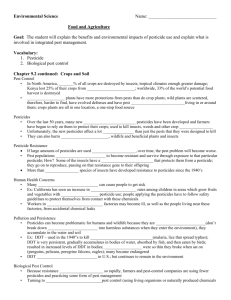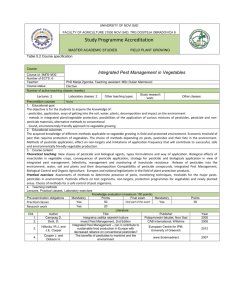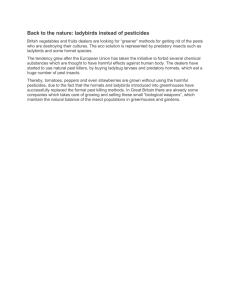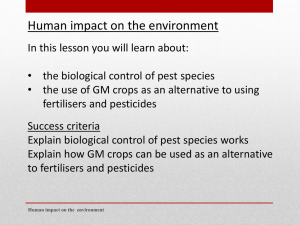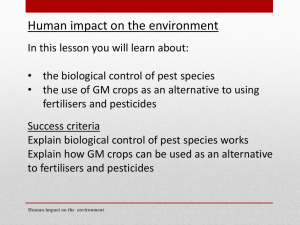9.4 student notes CD - Plain Local Schools
advertisement
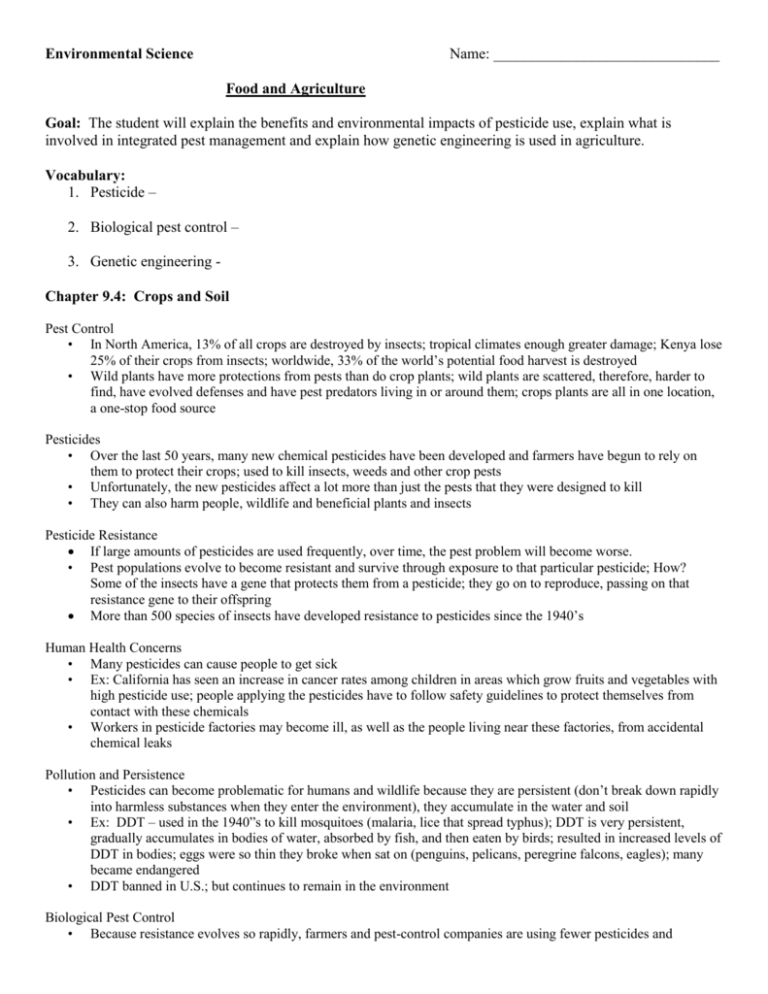
Environmental Science Name: ______________________________ Food and Agriculture Goal: The student will explain the benefits and environmental impacts of pesticide use, explain what is involved in integrated pest management and explain how genetic engineering is used in agriculture. Vocabulary: 1. Pesticide – 2. Biological pest control – 3. Genetic engineering Chapter 9.4: Crops and Soil Pest Control • In North America, 13% of all crops are destroyed by insects; tropical climates enough greater damage; Kenya lose 25% of their crops from insects; worldwide, 33% of the world’s potential food harvest is destroyed • Wild plants have more protections from pests than do crop plants; wild plants are scattered, therefore, harder to find, have evolved defenses and have pest predators living in or around them; crops plants are all in one location, a one-stop food source Pesticides • Over the last 50 years, many new chemical pesticides have been developed and farmers have begun to rely on them to protect their crops; used to kill insects, weeds and other crop pests • Unfortunately, the new pesticides affect a lot more than just the pests that they were designed to kill • They can also harm people, wildlife and beneficial plants and insects Pesticide Resistance If large amounts of pesticides are used frequently, over time, the pest problem will become worse. • Pest populations evolve to become resistant and survive through exposure to that particular pesticide; How? Some of the insects have a gene that protects them from a pesticide; they go on to reproduce, passing on that resistance gene to their offspring More than 500 species of insects have developed resistance to pesticides since the 1940’s Human Health Concerns • Many pesticides can cause people to get sick • Ex: California has seen an increase in cancer rates among children in areas which grow fruits and vegetables with high pesticide use; people applying the pesticides have to follow safety guidelines to protect themselves from contact with these chemicals • Workers in pesticide factories may become ill, as well as the people living near these factories, from accidental chemical leaks Pollution and Persistence • Pesticides can become problematic for humans and wildlife because they are persistent (don’t break down rapidly into harmless substances when they enter the environment), they accumulate in the water and soil • Ex: DDT – used in the 1940”s to kill mosquitoes (malaria, lice that spread typhus); DDT is very persistent, gradually accumulates in bodies of water, absorbed by fish, and then eaten by birds; resulted in increased levels of DDT in bodies; eggs were so thin they broke when sat on (penguins, pelicans, peregrine falcons, eagles); many became endangered • DDT banned in U.S.; but continues to remain in the environment Biological Pest Control • Because resistance evolves so rapidly, farmers and pest-control companies are using fewer pesticides and • • practicing some form of pest management Turning to biological pest control (using living organisms or naturally produced chemicals to control pests); every pests has enemies in the wild and those enemies can be used to control pest populations (ex: In India (mid1800’s), American prickly pear cactus had been introduced into India to feed insects that are used to make a valuable red dye; Cactus had no natural enemies, grew and spread. Plants were finally controlled by the introduction of an American beetle that eats cactus Generally, do no harm anything but the particular pest it is designed to control, resistance takes longer to evolve Pathogens • Releasing a natural predator or parasite is one method of biological control • Pathogens (organisms causing disease) is another method • Ex: Bacillus thuringensis (bacterium) kills larvae (caterpillars of moths and butterflies) Plant Defenses • Cross breeding some plant varieties to produce crops that have their own defenses • Tomato plants labeled “VNT” means they are resistant to certain fungi, worms and viruses • Ex: production of chemical compounds that repel pests; tougher skin Chemicals From Plants • Another type of biological pest control is to make use of plants’ defense chemicals (Ex: extracting chemicals from the chrysanthemum and sell it as a pesticide) • They are biodegradable (can be broken down by bacteria and other decomposers) and are designed for use in the home because they do not harm humans or pets Disrupting Insect Breeding • Growth regulators are chemicals that interfere with some stage of a pest’s life cycle (ex: dogs – flea pills prevent flea eggs from developing) • Pheromones - chemicals produced by an organism that affect the behavior of another - are also used • Ex: female moths find mates by releasing pheromones that attract males, farmers treat crops with those pheromones to confuse the males (interferes with mating) • Another example: treat male insects with x-rays, making them sterile; when they mate, eggs do not get fertilized Integrated Pest Management This is a modern method of controlling pests on crops (see handout) Not designed to eliminate pest populations but to reduce pest damage to a level that causes minimal economic damage; program is designed for specific crops; can include a mix of farming methods (biological pest control and chemical pest control) Used at specific times in the growing season, fields are monitored at all times during the growing season, when significant pest damage is found, pest is identified and program to control the pest is created Biological methods are the first methods used to control the pest (natural predators, pathogens, parasites of the pest) Cultivation controls can also be used As a last resort, insecticide may be used; changed over time so they do not have the ability to evolve resistance Engineering a Better Crop Plant breeding has been used since agriculture began; farmers select best tasting tomato plants, least pest damage, save seeds and use them the next year; consequently, these plants are more likely have genes for large, tasty tomatoes and resist pest A faster way to get the same result is to use genetic engineering (genetic material in a living cell is modified for medical or industrial use); they will isolate genes from one organism and implant it into another to get the desirable trait they are looking for (ex: pest resistant) Plants resulting from genetic engineering are called genetically modified plants (GM) (See handout for steps used to produce a GM plant) Implications of Genetic Engineering In US, we now eat and use genetically engineered agricultural products every day Many have not been fully tested for environmental impacts; could cause problems in the future (ex: genes are sometimes transferred from one species to another in the wild) GM corn plant could pass its genes to a wild corn plant; then, that corn plant could not be eliminated by a pesticide Sustainable Agriculture • How can we feed the world’s population without depleting the world’s resources? • Low-input farming – farming without using a lot of energy, pesticides, fertilizers and water • Ex: organic farming – farming without the use of synthetic materials, use manure, compost and keep the land planted at all times (reducing erosion), alternating crops • Aquaculture – “fish farming” or raising fish in artificial environments Lesson Reflection: - YouTube Video: The Eyes of Nye – Genetically Modified Foods (25 min) w/Handout Assessment: 1. Define the term pest. 2. Describe how biological pest control is part of integrated pest management. 3. Describe how genetic engineering is used in agriculture. Active Reading: Crops and Soil Lesson Extension (Technology/Application/Connection to Real World): Compare the benefits and environmental impact of pesticide use. Learn 360 – The Exterminator (45 min)

